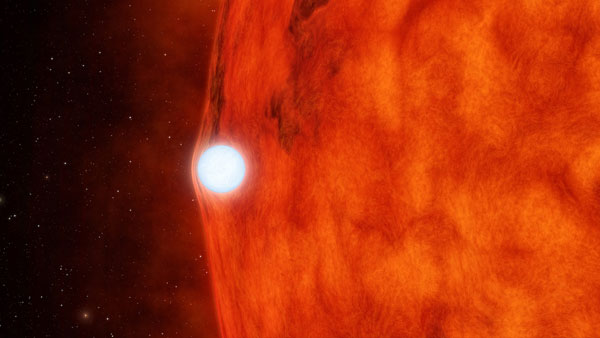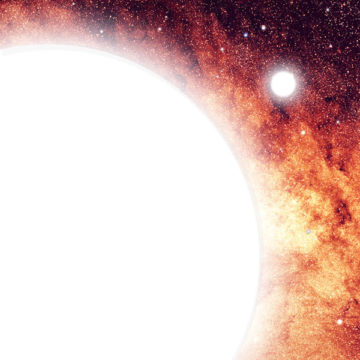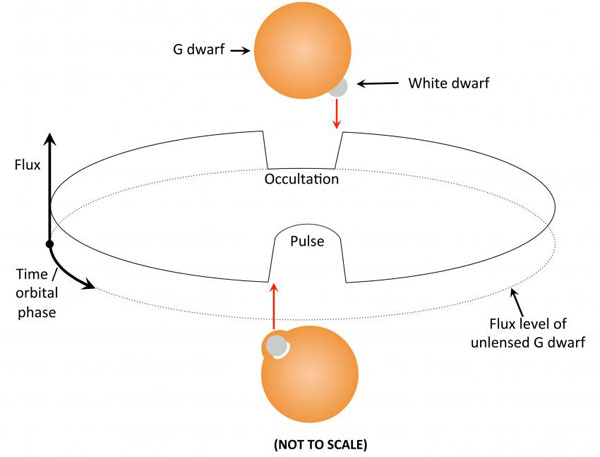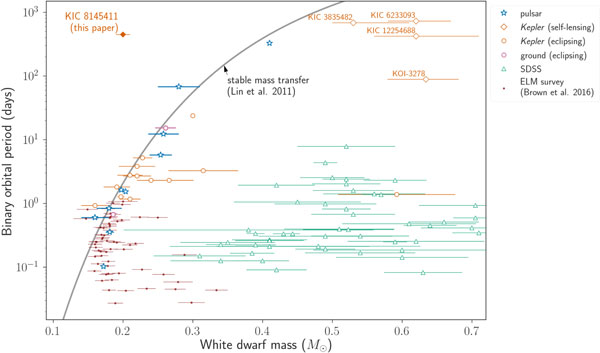Though Kepler’s primary mission ended years ago, the resulting dataset remains a vast playground in which astronomers continue to discover new surprises in stellar light curves. The latest? Evidence of a white dwarf that defies all expectations.

NASA / JPL-Caltech
Forming a Lightweight

CfA / David A. Aguilar
White dwarfs come in a range of different sizes. A typical white dwarf might be around 0.6 solar mass and arise when an isolated star of perhaps a few times the mass of the Sun expands into a red giant, exhausts its fuel supply, and puffs off its outer layers, leaving behind its dead, dense core.
But some observed white dwarfs have much lower masses — say, between 0.15 and 0.3 solar mass. To produce such a small remnant mass, the mass of the initial progenitor star would also have to be very low. But this poses a problem: smaller stars take longer to evolve, so a star of such low mass would need longer than the age of the universe to exhaust its fuel supply!
Since isolated stellar evolution can’t explain extremely low-mass white dwarfs, astronomers have settled on another explanation: binary interactions. In this scenario, the close orbit of two stars in a binary results in material being stripped away from the progenitor star, accelerating its mass loss and allowing it to evolve into a very low-mass white dwarf.
So far, this explanation has fit our observations. But now, the discovery of a new low-mass white dwarf is challenging our understanding.

Eric Agol
Self-Lensing Surprise
In a new publication, a team of scientists led by Kento Masuda (NASA Sagan Fellow at Princeton University) present the discovery of the binary system KIC 8145411 from Kepler data. This unique binary is one of only five known self-lensing systems: one object in the binary gravitationally lenses the light of the other as it passes in front once per orbit.
Masuda and collaborators use follow-up observations from the Fred Lawrence Whipple Observatory in Arizona and the Subaru telescope in Hawaii to pin down the properties of the system, confirming that we’re looking at a 0.2 solar-mass white dwarf orbiting a Sun-like star in an edge-on, eclipsing orbit.
But here’s the catch: KIC 8145411’s orbit is quite wide, at 1.28 AU (a period of ~450 days) — ten times too wide for the primary and the white-dwarf progenitor to have interacted in the way we’d expect. How, then, did this “impossible” white dwarf come to exist?
Tip of the Iceberg

Masuda et al. 2019 / Astrophysical Journal Letters 2019
Masuda and collaborators discuss a few proposed formation mechanisms — like interactions with a since-ejected or swallowed tertiary object — but none of them are especially satisfying.
So what’s next? The authors point out that we had only a 1 in 200 chance of detecting this particular system, due to its edge-on orientation — which likely means that KIC 8145411 is just the tip of the iceberg. Now that we know what we’re looking for, dedicated searches may turn up many more of these systems in the future — hopefully helping us to explain why this white dwarf is possible after all!
Citation
“Self-lensing Discovery of a 0.2 M⊙ White Dwarf in an Unusually Wide Orbit around a Sun-like Star,” Kento Masuda et al 2019 ApJL 881 L3. doi:10.3847/2041-8213/ab321b
This post originally appeared on AAS Nova, which features research highlights from the journals of the American Astronomical Society.
 9
9









Comments
Dan Tilque
August 16, 2019 at 4:50 am
How certain is it that the smaller star is a WD? Could it be a red dwarf?
You must be logged in to post a comment.
Anthony Barreiro
August 17, 2019 at 7:12 pm
Section 3 of Masuda et al.'s article (linked at the end of this S&T article) makes a compelling argument that the companion star is a white dwarf even though the companion is too dim for its light to be measurable through the glare of the bigger brighter G dwarf. They characterized the G dwarf spectroscopically and determined that it is 1.1 solar masses. Based on radial velocity the companion is 0.2 solar masses. Based on the strength of the gravitational lensing, the companion has a maximum radius of 0.02 solar radius. To be that massive and that small, the companion has to be a white dwarf. A 0.2 solar mass red dwarf would be much less dense, i.e. much bigger and fluffier, and would not show a strong gravitational lensing effect.
If you have a testable alternative hypothesis that the companion could be a red dwarf, I would be interested to read it.
You must be logged in to post a comment.
Rod
August 18, 2019 at 10:07 pm
Anthony, I think you are correct. A star about 0.2 solar mass with radius 0.02 solar would have a mean density near 3.52E+4 g cm^-3 and the gravitational red-shift at the surface using GR for a photon would be near 2.12E-5 compared to the Sun's 2.1E-6 red-shift. mean density near 1E-5 g cm^-3 and gravitational red-shift of photon at surface 1E-4 is in the white dwarf range of Sirius B and 40 Eri B, white dwarfs.
You must be logged in to post a comment.
Rod
August 19, 2019 at 8:43 am
oops, Sirius and 40 Eridani white dwarfs, mean density in the range 1E+5 to 1E+6 g cm^-3. The mass of 0.2 solar and 0.02 solar radii falls in the range and also GR, gravitational red-shift of photon at the surface it appears so likely a low mass white dwarf causing problems :).
You must be logged in to post a comment.
Andrew James
August 17, 2019 at 11:31 pm
The white dwarf could possibly be a unusually stripped stellar core. When its progenitor neared the end of the main sequence, and started to swell, found that the outer material was either absorbed by the 1.12 solar mass star we see today or has been already dispersed into the ISM. This might be also another Algol Paradox-like situation, where we are fooled to think the companion has always been the biggest/massive. Adding the possiblity is that this system might have been a multiple star, where the dynamics have caused loss of other components, and consequently changed the nature of the orbits (migration) of the remaining stars. Combining both of these scenerios may account for such binary systems. Masuda et al. paper points out: "...the core somehow needs to lose ~50% of its mass during or after the interaction." How could this be done?
If the determined orbital eccentricity is 0.14 ± 0.02 (and not the expected 0.00), then the existence of a past (or current perturber) is likely. e.g. Masuda et al. says: "There may exist a path involving a tertiary star that made it possible for the binary to interact when the WD progenitor was in the RGB phase. For example, the orbit may have once been highly eccentric due to perturbations from the tertiary star, or may have been significantly widened via a rare stellar encounter after the binary interaction in a close-in orbit." Q. How certain is this eccentricity?
Masuda et al. in this article also importantly says: "Rather, systems like KIC 8145411 could be progenitors of the ELM WDs in tight degenerate binaries: the mass transfer from the more massive, current stellar primary will likely be unstable, and the system may undergo common-envelope evolution to form a tight binary consisting of an ELM WD and a more massive WD." This points out that some more dramatic cataclysmic variable stars we see are somehow related in later evolutionary terms.
As a comment, the problems with determining parameters of these systems with small massed companions are numerous. An example is a paper by Lee, et al. (2015) "KIC 4739791: A New R CMa-type Eclipsing Binary with a Pulsating Component" [arXiv:1511.03764], who say: "KIC 4739791 is an Algol system with the lowest mass ratio ever observed and is considered an R CMa-type star that exhibits a very short orbital period." Looking at their Table 1. shows how difficult finding definitive results can be. (This is the diiect opposite scenerio from KIC 8145411, because its period is 0.89891 days.)
Another of these problem variable groups are the EL CVn-type binaries. As Chen et al. (2017) "The Formation of EL CVn-type Binaries" [arXiv:1604.01956v2] says: "We show that EL CVn binaries cannot be produced by common envelope evolution as previously believed because this process leads to merging of the components when giants have such low-mass cores." However, the period of EL CVn's are 2.2 days.
There seem some commonality here with either R CMa-ype or EL CVn-types, at least, in how low mass companions are made. As Chen et al. (2017) above say in their Appendix A: "Here we make a simple analysis on the common envelope evolution (CEE) channel for the formation of EL CVn-type binaries. A reasonable and commonly used approximation for CEE is based on energy conservation. As a companion star spirals in a giant’s envelope, due to friction between the inner binary (the giant’s core and the companion) and the envelope, the orbital energy is released and deposited in the envelope, and a part of the energy may be used to eject the envelope." They show why this is not possible, stating: "This means that the CEE can not produce the observed EL CVn-type stars." It is interesting that this same paper concludes : "..an intrinsic peak mass around the minimum mass of proto- He WDs (∼ 0.16 solar masses), which is only determined by initial composition and does not depend on details of the mass transfer processes." If true, then there might be something really peculiar with these stars' composition in making such low mass white dwarfs that we don't quite understand. (Chen et al. (2017) BTW concludes that such 0.2 solar mass white dwarf stars are around 400 million years old.
Perhaps as Chen et al. points out ; "...non-conservative mass transfer is among the major uncertainties in binary evolution. Here we examined two other assumptions in the modeling binary evolution, that is, the mass transfer process is completely conservative (all the mass lost from the donor is accreted by the companion) or completely non-conservative (no mass to be accreted by the companion)."
Why KIC 8145411 defies the white-dwarf mass-period relationship is puzzling, but IMO, this was once a very close binary system, but some external catastrophic event occurred in the distant past, which migrated the companion into a wider orbit. (Just like Jupiter may have done in the distant past after the Solar System had formed.
NOTE: It could have red dwarf that was core stripped, like red dwarfs may do to their own exoplanets, however, the final WD would be too small in this case.
You must be logged in to post a comment.
Rod
August 19, 2019 at 9:00 am
"But this poses a problem: smaller stars take longer to evolve, so a star of such low mass would need longer than the age of the universe to exhaust its fuel supply!" My opinion - this comment explains the concerns here over very low mass, white dwarfs in the galaxy. We would again, have objects in the galaxy older than the Hubble time or Big Bang event based upon the Hubble constant and what stellar evolution theory allows for age calculations, just like in recent years past, the ages of globular clusters plotted on the H-R diagram that were older than the Hubble time for the age of the universe. If this is the case, not the first time for stuff like this in astronomy 🙂
You must be logged in to post a comment.
Andrew James
August 19, 2019 at 10:23 pm
Stars exceeding the age of the universe (as a problem) no longer is relevant. New stellar evolution theory no longer follows this view. (Now for + 8 years!) [Frankly, this article even mentioning 'the age problem' isn't actually relevant in this story at all.]
As the article says: "Since isolated stellar evolution can’t explain extremely low-mass white dwarfs, astronomers have settled on another explanation: binary interactions. In this scenario, the close orbit of two stars in a binary results in material being stripped away from the progenitor star, accelerating its mass loss and allowing it to evolve into a very low-mass white dwarf." So. Stars being stripped of their envelopes accelerate the transition from stars to white dwarfs. The reason why the core mass is low is because it hasn't the time to develop as much as an ordinary star would. As I mentioned before, R CMa-type or EL CVn-type variables show this effect. The problem with this star is that it is not a close binary: meaning either some other catastrophe occurred (forcing it to a wider orbit) or another unknown mechanism exists. e.g. The 'catastrophe' could have been during an earlier common envelope (CE) phase when "... like interactions with a since-ejected or swallowed tertiary object."
You must be logged in to post a comment.
fif52
August 19, 2019 at 6:33 pm
Great comment. Can't seem to find it's direction in the sky but saying that a topic from Nov 2018 has a similar thing happening, 'Glowing Serpent Found in the Sky's.
You must be logged in to post a comment.
Rod
August 20, 2019 at 11:30 am
I am glad that Sky & Telescope in this report pointed out a potential age conflict between dating the low mass white dwarf and age of the universe. This problem does indeed pop up from time to time, including recent stars dated near 13.8 billon years old or perhaps older. My home database I keep, tracks some of these issues. "The Hubble time measures the age of the universe since the Big Bang, using the Hubble constant. The Hubble constant is generally expressed as km/second/megaparsec (1 megaparsec = 3.26 million LY). The larger the Hubble constant, the less time that has elapsed since the Big Bang and the younger the universe must be. How old is the universe according to the Hubble constant? Quick history: (A.) Edwin Hubble is credited with discovering the expanding universe from galaxy red shifts in the 1920s. The result was the Hubble constant which attempts to measure the rate of expansion of the universe. (B.) In the 1930s, the Hubble constant pointed to a universe that started its expansion about 1E+9 years ago. This contradicted what astronomy was teaching about "the development of individual stars and systems of stars takes considerably longer. It is in no way known how this incongruity is to be overcome." Ref: Relativity, The Special and The General Theory, Albert Einstein, Crown Publishers Inc., 1961, p. 134. (C.) In the 1940s and early '50s, not much better, about 1.8E+9 years old universe. Problem with this situation was that radiometric dated rocks were at least 3 billion years old and in 1955, the age of the earth was established at 4.56 billion years old. An error was discovered in measuring galaxy distances based upon Cepheid variables (galaxies much farther away then had been thought). The age of the universe increased to at least 5E+9 years old. Ref: "The Evolutionary Universe" by George Gamow, Scientific American, September 1956. Reprinted in New Frontiers in Astronomy, W.H.Freeman and Company, 1975, p. 320. (D.) Today the Hubble constant points to a universe in the range of 8E+9 <= universe age <= 16E+9 years old. This would be the Hubble time. Based upon my readings, the most popular value for the Hubble time is 13.7E+9 years old according to publications today."
I am adding this my report to my home database too 🙂
You must be logged in to post a comment.
You must be logged in to post a comment.